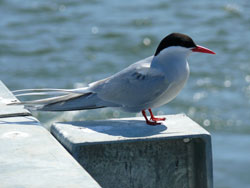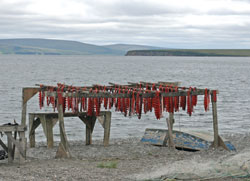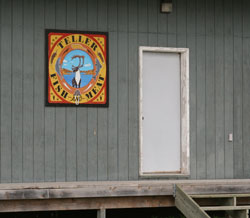Teller Highway
Mile 72 Teller and Grantley Harbor
Habitat: Human-modified, coastal beach, tundra meadow, and ponds

The road returns to sea-level and the dominance of marine water environment at its end in Teller. Again, lowland meadows flank the coastline and a sandspit arcs away from the landmass in relatively shallow waters. Marine mammals and birds are common sightings and give a chance to expand the list of wildlife found on seventy miles of mainland tundra.
Notable Wildlife Along Grantley Harbor
- Spotted seals are often seen on calm days, their heads popping up inquisitively at the tip of the spit.
- Pelagic cormorant, pigeon guillemot, horned puffin, common eider, and black scoters are seen here.
- Arctic terns and glaucous gulls actively feeding signal a fish run.
- White wagtails sometimes nest in a local cemetery. Ask locally for directions and permission to view the nesting pair.
The Cycle of Subsistence in Teller

Most Teller residents participate in some form of subsistence harvesting. In spring, people eat new willow shoots (sura) fresh with seal oil. They gather sourdock, wild celery (tukaayuk), and other local greens in summer. In late summer, they pick salmonberries and blueberries, and later crowberries. The root of a sweetpea (masru) gathered in fall is prized, and some still hunt for “mouse nuts”: cottongrass seeds cached in grass tunnels by voles. Inupiaq tradition requires that you replace the mouse nuts with some other bit of food.
In the spring after the ice goes out and again in the fall, people use gillnets to catch herring, whitefish, and tomcod. In midsummer, fish nets may be set perpendicular to shore while racks along the beach and amongst the homes are hung with drying salmon. Many people also have fish camps upriver or along the coast. All five salmon species swim through here, but red salmon, which migrate inland to spawning grounds at Salmon Lake, is the primary catch. Chum salmon pass through in July bound for the Pilgrim River while a second run arrives in late August headed to spawning grounds in the Agiapuk River. Occasionally a prized king salmon turns up in a net. In September, residents catch starry flounder in gillnets. In summer, they fish upriver for northern pike using gillnets and fishing poles; in the winter, they catch pike with hand-lines at holes cut in the river ice.
While freezers are stocked with moose and muskoxen, villagers also hunt seals, primarily spotted, ringed, and bearded seals. Seal meat and seal oil are staples in a traditional Native diet. How one learns to hunt, who they hunt with, how the meat is divided and shared, how it is preserved, and the occasions on which it is served continue to serve as the cultural glue that binds a community like Teller together.
A Brief History of Teller

Before any non-Native settlements grew in this region, people moved between small seasonal camps and villages, following the fish and wildlife. There were numerous seasonal camps in the Teller area but no permanent settlement.
In 1848 the first commercial whaling ship sailed through the Bering Strait and was followed soon after by traders. A Western Union expedition scouting a route for an intercontinental telegraph line across the Bering Strait spent the winter of 1866-67 camped on the spit across from Teller. From 1892 to 1900, the United States Government operated a reindeer station nearby, named for United States Senator and Secretary of the Interior, Henry Moore Teller.
The town of Teller in its current location boomed in the early 1900s with the discovery of gold in the nearby Bluestone River and the passage of ocean vessels and barges traveling to the Kougarok gold fields farther inland. Teller also became a trading center for Inupiat from Diomede, Wales, Mary’s Igloo, King Island, and the Russian coast. Many relocated to Teller, first because of the economic opportunities and later so their children could attend school. During these early boom years the town reached a population of about 5,000.
The flu epidemic swept through Teller in 1918 and 1919 followed by the tuberculosis epidemic two years later, decimating the Inupiat population. Many orphaned children were sent upriver to a Catholic orphanage at Pilgrim Hot Springs. Despite this devastating blow, the people and the community persevered.
Teller briefly drew international attention in May 1926 when Roald Amundsen and a crew of fifteen made the historic first flight from Europe to North America in the airship Norge. They left from Spitsbergen, Norway, passed over the North Pole, and made first landfall in North America at Teller before continuing on to Nome.
Their reliance on the area’s many subsistence resources helped local people weather the rise and fall of the mining and reindeer industries, the turbulent years of World War II when village men fought overseas, and the rapid changes stemming from the influx of Western culture.
Today, Teller is an Inupiat village that blends a cash economy with subsistence hunting, fishing, and gathering. The primary employers include the school, the city office, Native corporations, the health clinic, the power and water plants, and seasonal construction work. One locally-owned reindeer herd remains active, and some residents earn money by selling ivory, antler, and bone carvings. Though casual observers may not see many subsistence activities underway, a peek in most residents’ freezers reveals a host of wild foods harvested locally and delicacies acquired in trade from villages around the region.
